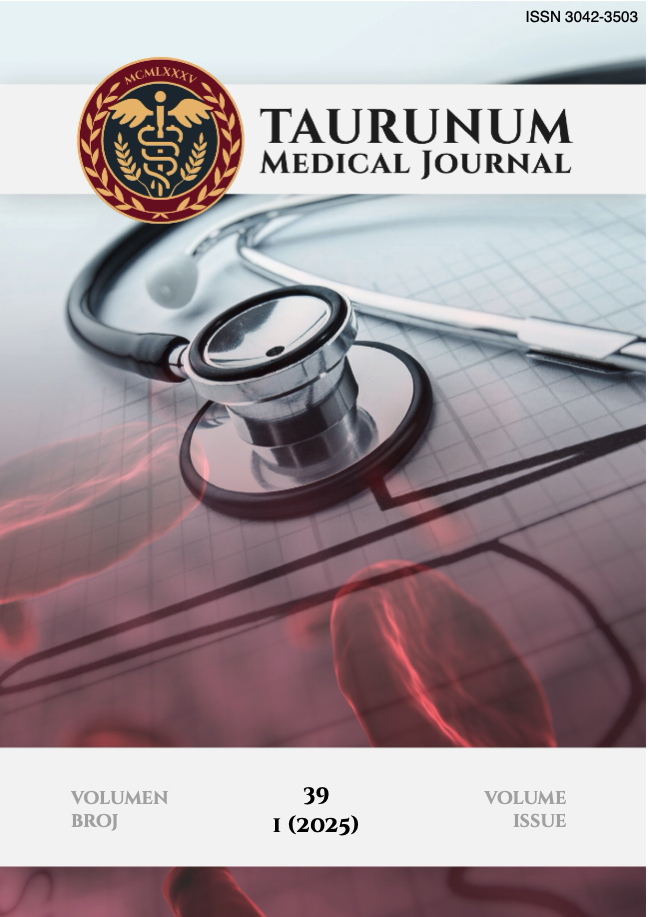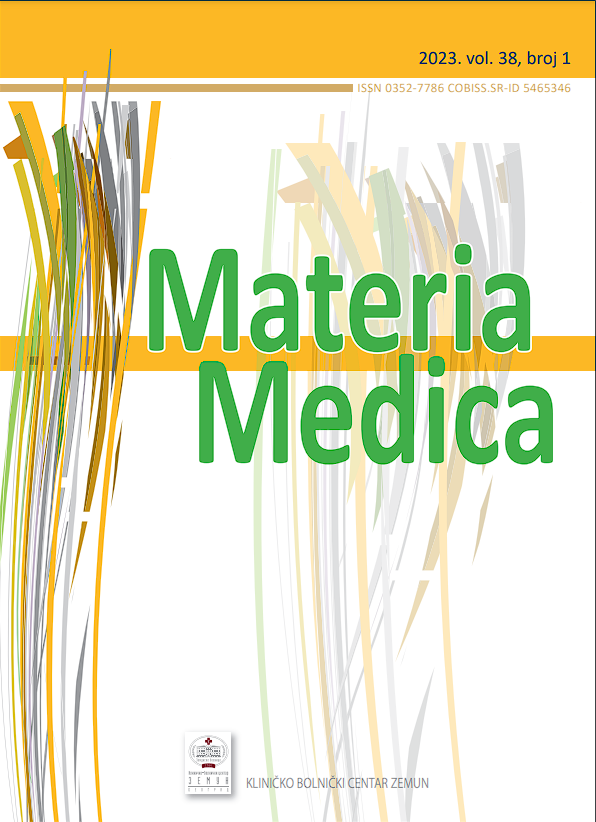Current issue

Volume 39, Issue 1, 2025
Online ISSN: 3042-3511
ISSN: 3042-3503
Volume 39 , Issue 1, (2025)
Published: 31.03.2025.
Open Access
Welcome to Issue 39, No. 1 – the first of our two annual publications for this year. Inside, you'll find a curated selection of articles. Start your year with the essential knowledge and perspectives offered in this timely edition
All issues
Contents
31.03.2025.
Review Article
Severe Dyspnea Caused by a Massive Neck Mass - Report of a Case
This case report describes a 61-year-old female patient who presented to the emergency room of our hospital with severe dyspnea. The patient reported experiencing breathing difficulties for the past 2 weeks, with daily worsening, as well as swallowing problems persisting for about a year. She denied any comorbidities or history of neck-related injuries or surgeries. Physical examination revealed significant swelling on both sides of her neck. Computed tomography was performed to further investigate her condition. The neck CT showed a massive tumor that completely replaces both lobes of the thyroid gland and extends into the mediastinum. Urgent endotracheal intubation was carried out, followed by angiography to assess the tumor mass's vascularization. The patient was then tracheotomized, and a biopsy of the tumor mass was performed. Histopathological examination revealed insular carcinoma of the thyroid gland. The hospital stay was complicated by respiratory failure and paratracheal tumor bleeding, leading to a fatal outcome.
Svetlana Valjarevic, Milan B. Jovanovic, Jelena Gavric, Sara Dragovic, Teodora Tadic, Djordje Nadjevic
31.03.2025.
Original Article
Epidemiological characteristics of Covid19 positive patients in triage centre CHC Zemun
In setting of still present Covid19 infection, the aim was the analysis of epidemiological and demographical characteristics of Covid19 positive patients that were treated in our triage centre from September until December 2021. They had positive antigen or RT-PCR test on SARS-CoV2. Randomly selected patients in our triage centre were offered to fill in an anonymous questionnaire specifically designed for this study. The questionnaire examined demographic and socio-epidemiological characteristics of these patents, and the questions were of closed type. Hospitalised patients were noted. The group of 226 patients answered questionnaire. Statistic shows 55.8% were woman. Patients older than 60 years made 53.1% of the group with average alter of 58.35 ± 16 years. Most patients were vaccinated with Sinopharm ™ vaccine (66.3%). Majority of patients had Covid19 infection for the first time, used personal protection equipment, practice proper hygiene and respected epidemiological measurements. Employed and patients in pension were almost equally distributed (43.1% employed, 45.3% in pension). Among hospitalised patients (20.5%), it was statistically significant distribution of older patients mean alter 66.8 years, and non- vaccinated patients 67.5%. Statistical analysis has shown a significance regarding the previous lung diseases and hospitalisation (p-vrednost=0,008). There was no statistical significance in vaccination status in whole group. Older people with more comorbidities are in higher risk of getting more severe form of Covid19 infection, and as such, are at a higher risk for hospitalisation. Patients that were vaccinated had a lower degree of hospitalisations, and therefore a milder form of the disease. Considering this data, we would recommend vaccination for Covid19, especially in older patients with comorbidities.
Karapandžić M, Indjić Dj, Marić N, Kušić Miličević J, Vujčić I, Marjanović M, Jemcov T
31.03.2025.
Review Article
Massive Sinonasal Polyposis in an Elderly Patient: Report of a Case
We present the case of a 70-year-old female patient who sought consultation with an otolaryngologist due to a mass protruding from the left nasal cavity. The patient reported that she had noticed the mass for the past two months, although she had experienced nasal breathing difficulties for over ten years. Upon examination, a large pink mass was observed protruding from the left nostril. Anterior rhinoscopy revealed complete obstruction of both the left and right nasal cavities by the tumor mass. Computed tomography showed that the mass entirely filled both nasal cavities and all paranasal sinuses. Surgical treatment was performed, involving endoscopic sinus surgery, which resulted in the complete removal of the mass. Histopathological analysis confirmed that the mass was a case of massive sinonasal polyposis. At the six-month follow-up, no signs of recurrence were observed. Although sinonasal polyposis is a relatively common condition in rhinologic surgery, such pronounced polyposis with prolapse of polyps through the nostril is a rare presentation that can initially mimic benign or malignant tumors of the nasal cavities.
Svetlana Valjarevic, Sara Dragovic, Jelena Gavric, Djordje Nadjevic, Milan Jovanovic
31.03.2025.
Review Article
The Importance of Intraoperative Exploration and Intensive Postoperative Monitoring in the Detection and Management of Synchronous and Metachronous Colorectal Tumors
Introduction: Colorectal cancer (CRC) is among the most common malignancies, with a rising global incidence. Synchronous tumors refer to the presence of multiple tumors simultaneously in different segments of the colon or rectum, while metachronous tumors occur during follow-up after initial treatment. These tumors are often undetected during standard diagnostic procedures, making intraoperative exploration and postoperative monitoring crucial for timely diagnosis and successful treatment. Case Report: A 63-year-old patient was admitted for sideropenic anemia and weight loss. Colonoscopy revealed a tumor in the cecum, confirmed as adenocarcinoma. During surgery, two additional tumor lesions were discovered in the ascending and transverse colon. Following an extended right hemicolectomy and adjuvant chemotherapy according to the FOLFOX protocol, the patient remained disease-free until May 2023, when a metachronous tumor in the rectum was detected. The lesion was removed via transanal excision, and histopathological findings indicated intramucosal carcinoma. Continuous follow-up until November 2024 showed no disease progression. Conclusion: Intraoperative exploration enabled the identification of previously undetected synchronous tumors, influencing the extent of surgery and the postoperative treatment plan. Regular monitoring, including colonoscopy and radiological methods, is essential for the early detection of metachronous tumors and achieving optimal outcomes. This case highlights the importance of a multidisciplinary approach in managing patients with synchronous and metachronous CRC.
Marija Nikolić, Nebojša Mitrović, Dejan Stevanović, Nemanja Trifunović, Jovana Trifunović, Milica Radivojević, Damir Jašarović
31.03.2025.
Review Article
Cervicogenic headache
Cervicogenic headache is a type of secondary headache that affects 0.17-4% of the general population and is defined by a primary lesion in the cervical spine with a painful syndrome in the head and/or facial area. It is characterized by unilateral pain on the side of the primary lesion in the neck, with variable accompanying symptoms that may pose a differential diagnostic challenge compared to other types of headaches. The most widely accepted mechanism of this headache's onset is the propagation of pain from the neck to the structures of the head, sometimes even to the face, due to the convergence of afferent neurons originating from the C1-C3 spinal nerves and nociceptive fibers of the trigeminal nerve in the trigeminocervical complex. Since most of the clinical characteristics of this headache are nonspecific, in the absence of a clear chronological connection to a lesion in the cervical spine, imaging or targeted nerve blockade is required to establish a diagnosis. The response to pharmacotherapy is often modest, and therapeutic methods include physical therapy, periodic injections of analgesics and/or corticosteroids into the joints of the cervical vertebrae or their associated nerves, as well as neurosurgical methods such as radiofrequency ablation and nerve decompression.
Vladimir Bošković, Armin Korać, Milija Mijajlović
31.03.2025.
Case Report
Case Report: Severe Upper Lip and Hard Palate Necrosis Associated With Chronic NSAID Abuse
A 67-year-old woman experienced extensive soft-tissue ulceration of the right upper lip and adjacent maxillary bone as a consequence of attempted abuse of aspirin (NSAID). All oral lesions healed within 28 days after local and systemic therapy. Oral ulceration has many potential causes ranging from physical trauma to malignancy. Chemicals are a less common cause of traumatic ulceration. Most chemical burns are characterized by mild to moderate tissue damage that heals spontaneously within seven to 15 days without scarring. The primary intervention involves discontinuing the aspirin use and addressing the underlying vascular compromise. Treatment may include supportive measures, wound care, and in severe cases, reconstructive surgery.
Drago Jelovac, Danilo Nikolić, Aleksandar Oroz
31.03.2025.
Review Article
The quality of life assessment in patients with hypothyroidism – our experiences from clinical practice
A sense of satisfaction and well-being that covers various aspects of life can be defined as quality of life (QoL). Hypothyroidism can be clinically both latent and apparent. It is possible to evaluate general aspects of life, identify the presence and severity of diseases, and evaluate the effectiveness of treatment while QoL measurement instruments are used. The timely initiation of levothyroxine (LT4) substitution in cases with latent hypothyroidism and the evaluation of LT4 substitution quality serve as evidence of the beneficial effects of used QoL instruments. Here, we introduced GHQ12, TSQ, and ThyPRO instruments most commonly used in routine thyroid clinical practice.
Bojan Joksimović, Milena Lačković, Vladimir Samardžić, Miloš Marinković, Marija Šinik, Zoran Gluvić
31.03.2025.
Case Report
Most Common Clavicle Fractures and Should They Be Operated On? - A case report
Clavicle fractures account for up to 4% of all adult fractures and are often the result of severe trauma in young individuals. At the Clinical Hospital Center Zemun, there have been just under 15 cases of these fractures treated surgically over the past 10 years (with the first author performing 6 of these surgeries). The relatively small number of operated patients is due to the belief that only a clavicle that does not heal on its own requires surgery. New osteosynthetic materials provide better treatment outcomes but cannot compensate for poor surgical technique, implant failure, incorrect indications, and/or choice of method, leading to treatment failure. We present an interesting case of a 45-year-old female patient who underwent surgical treatment for a clavicle fracture with multiple complications.
Marko V. Žunić, Edin Е. Redžepagić, Zoran V. Rosić
31.03.2025.
Review Article
Recurrent sialolithiasis in a patient with vitamin D hypovitaminosis
We present a case of a patient with recurrent sialolithiasis. Sialolithiasis is a condition characterized by mechanical obstruction of the excretory ducts of the salivary glands. The etiology of calculus formation remains unclear. Preoperative laboratory analyses indicated vitamin D deficiency. Computed tomography revealed calculi in the parenchyma of the deep lobe of the right parotid gland and in Stenson’s duct, which were surgically removed. A review of the literature shows no correlation between calcium levels of serum and saliva. However, vitamin D has an anti-inflammatory role, and its deficiency may lead to sialoadenitis, thus promoting sialolithiasis. The aim of this case presentation is to emphasize how changes in saliva composition and vitamin D deficiency may influence recurrent sialolithiasis.
Jelena Gavrić, Svetlana Valjarević, Đorđe Nađević, Goran Trajković
31.03.2025.
Review Article
Adenocarcinoma of the esophagogastric junction presented as a vegetative tumor in the hiatal hernia sac
Introduction: The incidence of esophageal and esophagogastric junction adenocarcinomas has been increasing in developed countries, with primary risk factors including gastroesophageal reflux disease (GERD), smoking, and obesity. Chronic GERD can lead to Barrett’s esophagus (BE), a premalignant condition that elevates the risk for esophageal adenocarcinoma. Case Report: We present a case of a 63-year-old woman with nausea and epigastric pain. Her history was notable for Sjögren’s syndrome and a positive family history of prostate cancer, without smoking or alcohol use. Endoscopy revealed a distal hiatal hernia and long-segment Barrett’s esophagus (LSBE) with a 3 cm ulcerated lesion at the gastroesophageal junction, located within the hernia sac. Biopsies confirmed well-differentiated adenocarcinoma in LSBE. CT imaging showed a tumor extending through the hiatal hernia with distal esophageal wall thickening and lymph node metastases but no distant metastases. The patient underwent a subtotal esophagectomy with lymphadenectomy and esophagogastric anastomosis using the Ivor Lewis procedure. Pathology confirmed adenocarcinoma with lymph node metastasis and a close circumferential resection margin. Six cycles of postoperative chemotherapy with platinum and fluoropyrimidine were administered. The patient was recurrence-free at a three-year follow-up. Conclusion: This case underscores the association between hiatal hernia, Barrett's esophagus, and esophageal adenocarcinoma, particularly in the setting of disrupted antireflux mechanisms. The findings support the importance of early investigation and monitoring in patients with GERD and BE to mitigate cancer progression.
Aleksandar Pavlović, Sara Filipović, Jovana Trifunović, Nemanja Trifunović, Miroslav Kreačić









